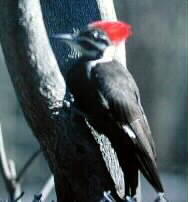| 12-09-02
Late bow and muzzle-loader seasons still are open, so it will be a while
before the last big rack story will be told. But a northwestern Indiana
hunter launches things with what could be the top non-typical deer rack
of the year.
Reports on the bagging of deer that sported big racks--record-book bucks--are
trickling in now. They will peak when the Indiana Deer Hunters Association
stages the annual Indiana Deer Exposition at the Indianapolis Boat, Sport
and Travel Show, February 14 - 16, at the Indiana State Fairgrounds in
Indianapolis.
During the first three days of the Sports Show official measurers of
the Indiana Deer Hunters Association (IDHA) will be measuring deer racks,
and this brings deer racks from everywhere, some taken in years past.
Incidentally, the IDHA is trying to get out another edition of the Hoosier
Record Book Program (HRBP) next year. But this is not yet a cut-and-dried
matter.
Now for that big deer. This 20-point non-typical was taken November
13 near Cedar Lake by John Quinlan, a St. John carpenter, with bow from
a ground stand.
Quinlan, who moved from Illinois to Indiana three years ago, said he
was sitting in his ground stand (in a brushy, wooded area) when his big
buck walked slowly past.
He stood up and shot the deer at about 12 yards, he said, and waited
about 20 minutes before finding his prize dead some 30 to 40 yards from
the spot where he took his shot.
The rack, which is being mounted by American Natural Resources, a taxidermy
business at Griffith, has been green scored at 214 7/8 (seven eights) gross,
and 203 7/8 (seven eighths) net. Should the net score hold up when the
rack is cured, Quinlan's deer would be tied for second place in bow non-typical
classification of the HRBP with a rack taken by Joe Fulford, Wawaka, in
1987. That one was taken in Noble County.
Quinlan, who places his overall success at 25 to 30 deer in Illinois
and Indiana, has two other racks registered by Pope and Young. Five days
before he took his Hoosier prize he took an 18-point non-typical rack in
Illinois. That one has been green-grossed at 204.
HOW TO FEED BIRDS--The
scientific guys tell us the feeding of birds and others among nature's
children is more an ego trip for the feeder than necessity for the critters.
But I find it difficult not to think that a bird with a full tummy has
a better chance of making it through a sub-zero night than a bird that
has had to struggle for his daily weed seed.
Thus, not only do I feed birds (throughout the year), but I try to do
it in the safest way for the birds and other critters.
I feed black oil sunflower seed (grade B, if I have a choice), and whole
kernel corn. Whole kernel corn is better than cracked corn for squirrels,
which eat only the tiny seed center of the grain. That turns the remaining
part of each grain into cracked corn for the birds.
To make it more difficult for marauding hawks to raid my feeder stations,
I place the grain under bushes or shrubs, or under a canopy of under story
brush.
A suet feeder also is a great way to feed birds. This will attract many
species, including every woodpecker that winters here.
Suet is the fat found around the kidneys of beef. Softer forms of fat
also will attract birds, but suet (the hard fat) is more crumbly and easier
for birds to eat.
Wire feeders (like those you see at bird food stores) will dispense
suet very well, but I prefer my homemade wire basket, which is fashioned
from little chicken wire with a mesh of roughly one-inch.
A strip of little chicken wire two feet long and one foot wide can be
folded and tied with a pliable copper wire along two of the three open
edges. This forms a thin basket which will hold a good amount of suet and
can be suspended from a tree limb with wire to thwart raids of raccoons
and other animals. When this basket is filled with suet it will be only
two or three inches thick, and its thickness will decrease as the suet
is used by birds. I have never seen a bird get inside the basket or be
trapped in any way.
Some grocery store meat counters offer suet, but a better source is
independent butcher shops.

A pileated woodpecker awaits
his turn at the suet feeder from a perch on the redbud tree outside my
back door. |
|

